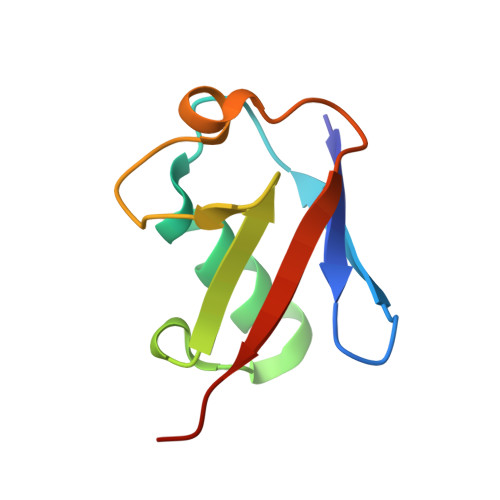Impact of different ionization states of phosphorylated Serine-65 on ubiquitin structure and interactions.
Kazansky, Y., Lai, M.Y., Singh, R.K., Fushman, D.(2018) Sci Rep 8: 2651-2651
- PubMed: 29422536
- DOI: https://doi.org/10.1038/s41598-018-20860-w
- Primary Citation of Related Structures:
5W46 - PubMed Abstract:
The covalent attachment of ubiquitin (Ub) or Ub chains to cellular proteins is a versatile post-translational modification involved in a variety of eukaryotic cellular events. Recently, the post-translational modification of Ub itself by phosphorylation has emerged as an important component of the Ub-signaling system. Specifically, Ub phosphorylation at serine-65 was shown to activate parkin-mediated mitochondrial quality control. However, the impact of phosphorylation on Ub structure and interactions is poorly understood. Here we investigate the recently reported structural changes in Ub upon serine-65 phosphorylation, namely, the equilibrium between a native-like and a novel, alternate conformer of phosphorylated Ub (pUb). We show that this equilibrium is pH-dependent, and the two pUb conformers are linked to the different charge states of the phosphate group. We examined pUb binding to a known Ub-receptor and found that the alternate conformer is binding incompetent. Furthermore, serine-65 phosphorylation affects the conformational equilibrium of K48-linked Ub dimers. Lastly, our crystal structure of S65D Ub and NMR data indicate that phosphomimetic mutations do not adequately reproduce the salient features of pUb. Our results suggest that the pH-dependence of the conformations and binding properties of phosphorylated Ub and polyUb could provide an additional level of modulation in Ub-mediated signaling.
- Department of Chemistry and Biochemistry, Center for Biomolecular Structure and Organization, University of Maryland, College Park, MD, 20742, USA.
Organizational Affiliation:

















